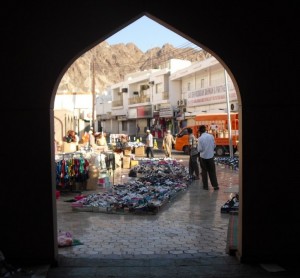One Thousand And One Nights in Oman
Allahu Akbar, Allahu Akbar
Allahu Akbar, Allahu Akbar
Ash-hadu an’ la ilaha ill Allah…
Haunting, beautiful, and otherworldly, the Adhan is the Muslim call to prayer, recited by a muezzin five times per day. The root of the word is “to permit,” and that’s exactly what the capital of the Sultanate of Oman, Muscat, does for visitors: permits them to see a world unlike any on earth.
Muscat stands in stark contrast to the nearby glitz and glamour of Dubai and Abu Dhabi with no high-rise buildings obscuring its Arab-esque architecture, ancient fortifications and stunning corniche. It’s a place where men wear spotless white robes, the traditional woven kuma hat and, for festive occasions, a khanjar (curved traditional dagger) in their belts, while women adorn long abaya cloaks. It’s the oldest independent state in the Arab world, ruled by the al-Said family since 1744. Dripping with such history and culture, it’s no wonder Muscat was named the second best city in the world to visit in 2012 by travel guide publisher Lonely Planet.
A trip to this sun-soaked capital, set along the Gulf of Oman and Arabian Sea, really is like stepping into One Thousand and One Nights. Modern conveniences like motor vehicles and electricity may be plentiful (which helps for running air conditioning in a place where temperatures regularly hit the triple digits Fahrenheit), but they do little to prevent one from slipping back in time.
The sense of temporal displacement begins almost immediately. Rising out of bed and throwing open the curtains, a white-washed vista blasted the eyes in an explosion of light that proved exactly why sunglasses are necessary in certain parts of the world. I was staying at the Al Falaj Hotel, a 4-star establishment of 140 rooms in the Ruwi district, one of the oldest parts of Muscat known for its narrow streets and central location. My seventh-floor suite with a queen-sized bed and walk-in shower was seemingly fit for a sultan — especially when combined with the sweeping views of the city it afforded — but I wasn’t in the country controlled by Portugal from 1508 to 1659, when the Ottoman Empire took possession, to spend the day sleeping.
My first destination was the corniche, the most ancient part of Muscat and the “Pearl of Arabia.” Documented in Western accounts as early as the first century AD by Greek geographers Ptolemy, who referred to it as “Cryptus Portus” (“Hidden Port”), and Pliny the Elder, who referred to it as “Amithoscuta,” evidence of human habitation in the area goes back possibly as far as 6,000 BC. Muscat means “anchorage,” and today the picturesque port is the ideal place to get a feel for what Oman might have been like in the days of Ali Baba or Sinbad, with frankincense — more prized in the Oman of yore than gold — wafting through the air in an intoxicating aroma that puts all under its spell. Fortunately that spell isn’t the least bit sinister, as Muscat is touted as the friendliest and safest city in the Middle East.
Even in the midst of the scorching midday heat, a walk down the paved sidewalk that frames the corniche is a great way to orient oneself to the sights, sounds and smells. Before the discovery of oil, the area around the corniche, known as Muttrah was the center of commerce in Oman. The modern port was inaugurated by Sultan Qaboos bin Said al Said in 1974, and his personal yacht, known as the Al Said (the fourth-longest yacht in the world), is often berthed in the harbor, surrounded by a buzz of traditional wooden sailing vessels known as dhows. The sidewalk around the corniche features numerous benches crowned by golden domes, meaning it’s a perfect place to sit down and simply watch life go by like a painting come to life.
Its Middle East location means Muscat can be brutally hot during the day, and to beat the heat there’s no better place than one of the great public markets of the world. Al Dhalam (“Darkness” in Arabic) Souq is the local name for the Muttrah Souq. Perhaps the oldest souq in the Middle East, it acquired its name because shoppers would need lamps or torches to navigate the crowded stalls and lanes where the sun did not penetrate. With the advent of electricity it’s now possible to visit without a personal light source, but the sprawling complex remains a world of twilight and shadow that, despite the regular crush of bodies, is always several degrees cooler than the broiling corniche that lays just a few steps away. The main thoroughfare of the souq carries mainly household goods, tourist curios, shoes and ready-made garments. But it’s further inside that the real adventure is.
The smells of frankincense, myrrh, perfume oils, jasmine and spices permeate the air, while stalls full of glimmering Omani silver, gleaming daggers, jeweled swords, brightly colored cloths, handmade hookah pipes, antique pottery, and rare incenses tempt even the most casual visitor. Shoppers can even get their hands on old Arabian muskets — some of which still work — if they’re so inclined. The sheer level of authenticity — a veritable Cave of Wonders — stands in stark contrast to other markets specializing in factory-produced products at steep discounts; Bishkek, Kyrgyzstan’s Osh Bazaar it is not.
(Article continued on next page)

